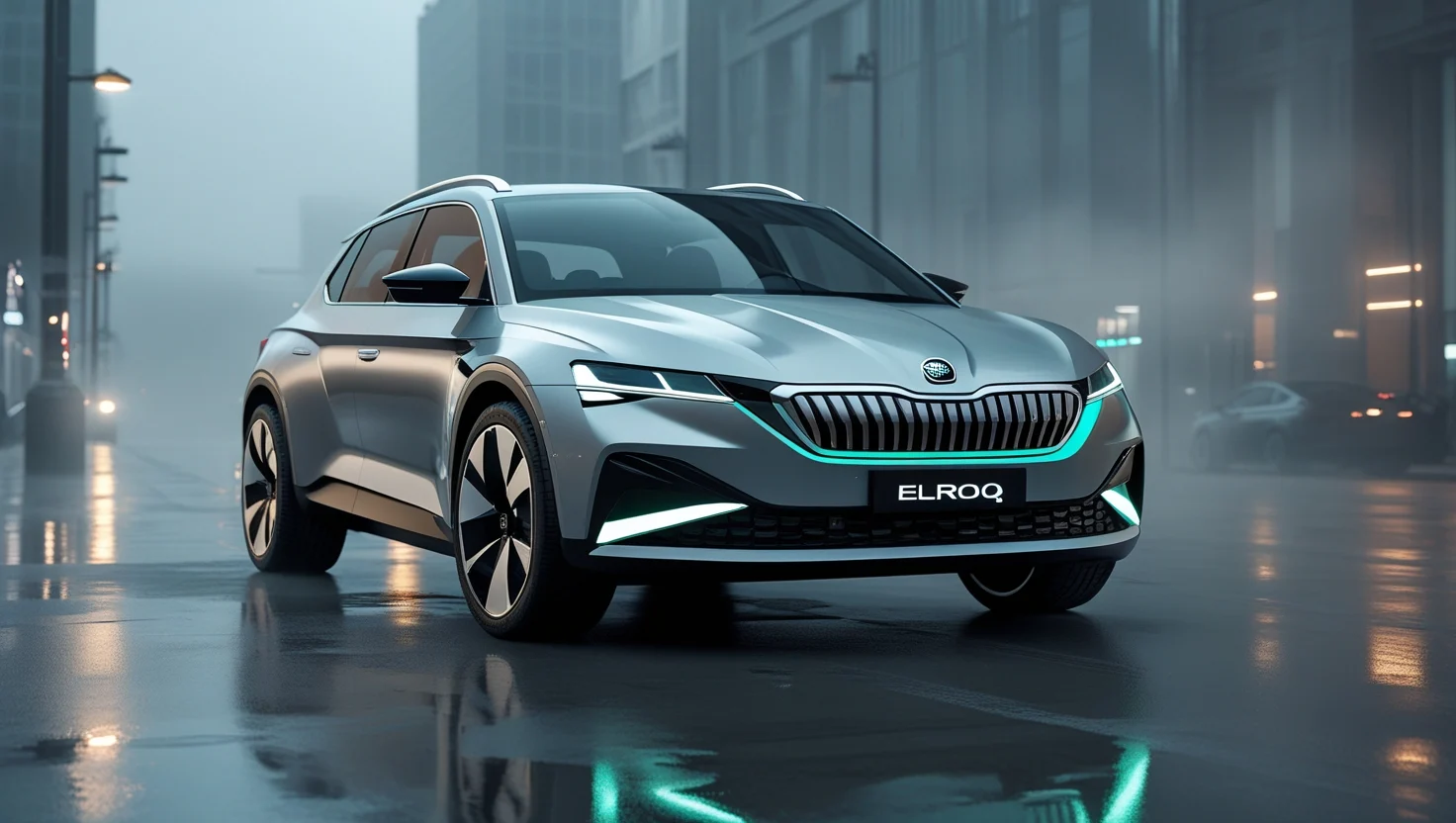Škoda Elroq 2025 Electric SUV — Full Review: Range, Batteries, Charging & Should-You-Buy Guide
The Škoda Elroq arrived in 2025 as the brand’s compact electric SUV aimed squarely at families and everyday drivers who want a roomy, tech-rich EV without paying premium luxury prices. This long-form guide breaks down what matters: the three battery choices and realistic WLTP ranges, claimed fast-charge times and practical charging advice, interior space and storage, safety/ADAS features, trim levels and pricing signals, plus how the Elroq compares with key rivals in the growing compact-EV segment. I quantify what Škoda officially says and what independent testing and databases show, so you get a clear picture of real-world range expectations, charging behaviour, and ownership costs. Whether you’re researching a first EV or comparing compact SUVs for family life, this article gives the facts, a test-drive checklist, and a decisive buying recommendation.
Quick facts at a glance
Launch / Production start: Elroq went into production for the 2025 model year as Škoda’s fresh compact EV offering.
Platform: Volkswagen Group MEB electric vehicle platform (same basic family as Enyaq/ID.4 derivatives).
Battery options (usable): multiple pack choices across the range (entry to long-range configurations). Independent reporting lists usable battery sizes roughly in the 50–77 kWh band depending on trim.
Claimed WLTP range: Škoda advertises strong long-range numbers for top packs; independent WLTP-based estimates go from ~232 miles (smaller pack) up to ~360 miles (largest pack) in some quoted conversions — real-world results vary.
Fast charging: the top Elroq can accept high DC power (reports of up to ~175 kW peak), with 10–80% times advertised in the sub-30-minute region on a suitable charger.
Price positioning: launched competitively — European starting prices were advertised around the low-to-mid €30k / £30k band for base models in initial markets.
Why the Elroq matters (short answer)
Škoda designed the Elroq to be an “everyday family EV” that packs long-range capability into a compact footprint, while keeping pricing competitive. That formula—good interior space, multiple battery options and a sensible feature set—aims to widen EV adoption beyond premium buyers and to challenge rivals that previously dominated the compact-EV slice. Škoda positions the Elroq as both practical and value-driven, with features and charging performance that make it viable for routine family trips and weekend journeys.
Design & interior — compact outside, roomy inside
Visually, the Elroq follows Škoda’s new “Modern Solid” design language: clean surfaces, a closed “Tech-Deck” front face, and practical detailing (hidden door pockets, sensible switchgear). Its proportions are compact compared with larger SUVs, but the wheelbase and packaging are optimized to prioritize cabin space over an oversized external footprint. That means:
Good front-seat comfort and visibility for urban driving.
Clever storage nooks and a family-friendly layout (cupholders, bins, and split-fold rear seats).
Boot capacity smaller than Škoda’s larger Enyaq but still very usable for prams, suitcases and shopping.
Škoda’s focus here was to offer the feel of a larger car inside a more city-friendly body — a useful tradeoff for buyers who want room without hard-to-park length.
Battery options & performance — pick what you need
One of the Elroq’s strengths is the choice of battery packs and power outputs. Škoda and independent specs outline a tiered setup so buyers can prioritize price, range, or performance:
Entry / Mid battery — a practical pack (roughly in the low-50 kWh usable range on some trims) that suits day-to-day commuters and short family trips.
Mid / Long battery — a 59 kWh-ish usable option in mid trims for balanced range and cost.
Top long-range battery — the biggest pack (roughly 77–82 kWh usable as quoted in different sources) aimed at buyers who want the least charging downtime and maximum trip flexibility.
Motors and outputs vary: single-motor rear-drive setups power the entry and mid trims, and dual-motor configurations appear on sportier or top-spec models delivering higher system power and quicker 0–100 km/h times for those who want it. The takeaway: choose the battery size that matches how you drive. If you rarely do long motorway runs, a mid pack usually delivers the best price/performance balance.
Range — WLTP vs real life
Manufacturers often quote WLTP or converted test-cycle figures that look impressive in marketing copy. The Elroq’s WLTP-linked ranges are competitive for its class — particularly with the largest pack — but expect real-world figures to be lower depending on conditions:
City driving usually yields the best efficiency thanks to regenerative braking; you can expect numbers closer to or occasionally above WLTP in benign conditions.
Highway driving and sustained speeds (e.g., 110–130 km/h) reduce range substantially compared with WLTP.
Climate & load — cold weather, heavy loads, roof boxes and air conditioning/heating can cut real range by 15–30%.
Independent WLTP-based conversions and early road tests show combined or “realistic” ranges that align with the usable battery sizes—broadly, mid packs are excellent for routine life while the biggest pack gives comfortable cross-country flexibility without frequent top-ups. Plan routes with public DC fast-charging options in mind if you regularly exceed 250–300 km per day.
Charging — what to expect on the road and at home
Škoda engineered the Elroq to work with modern charging networks and typical home setups:
Home charging (AC): overnight charging on a 7–11 kW wallbox will fully replenish mid-sized packs; larger packs take proportionally longer but are still practical for nightly charging cycles.
Rapid DC charging: the Elroq’s top variant supports high-power DC charging—reports list peak charge rates up to around 175 kW, which makes 10–80% charging times realistically capable of sub-30-minute sessions on compatible chargers. Note that charging speeds slow above ~80% to protect the battery.
Practical advice: use fast chargers for long trips and keep home charging as your day-to-day routine. If you live in an area with spotty fast-charger availability, the largest battery option reduces range anxiety but comes at higher purchase cost.
Tech & safety — connected, assisted, and sensible
Elroq trims come with a modern infotainment system, digital driver displays, OTA-capable connectivity and a suite of driver-assist systems. Higher grades include Level-2 capabilities such as:
Adaptive cruise control and lane-keeping assist.
Blind-spot monitoring and automated emergency braking.
Parking assistance aids and camera systems with clear menus and app integration.
Škoda has focused on making these features functional rather than showy — they work to reduce stress in daily driving and add real value for buyers who commute or drive family routes. The software-forward setup also lets Škoda push improvements over time through OTA updates.
Price, trims & value — where the Elroq sits
Škoda launched the Elroq at competitive pricing in Europe to undercut some premium rivals while offering better range/tech for the money. Early market pricing in the UK and Europe put entry models in the low-to-mid £30k/€33k territory, with higher trims and larger batteries pushing the price into a mid-range bracket — still cheaper than many premium alternatives. Trim levels are arranged to help buyers trade off equipment vs range:
Base / Value trims: sensible equipment, smaller battery, lowest price.
Mid / family trims: better kit, mid battery and comfort options.
Top / Sport & RS trims: dual-motor or sportier tuning, largest battery, and ADAS premium features.
Bottom line: the Elroq’s pricing strategy is to make long-range EV ownership accessible without premium marque premiums — good news for mainstream buyers who want an all-electric family SUV.
How the Elroq stacks up vs competitors
In the compact-EV SUV category the Elroq competes with models like the Hyundai Kona Electric, Kia EV3, Renault Scenic E-Tech, and smaller versions of the VW ID family. The Elroq’s advantages are:
Multiple battery sizes and a notably competitive long-range top pack.
Spacious, pragmatic interior and Škoda’s strong value positioning.
Competitive charging speeds on the top model.
Consider rivals on the basis of dealer network (Škoda’s is strong in Europe), warranty terms, and the total cost of ownership in your market (including subsidies). If you prioritize range and cabin usability at a fair price, Elroq is a solid option; if you need the smallest possible footprint or the absolute lowest purchase price, some rivals may win on sticker price or local conditions.
Test-drive checklist — what to confirm in person
Before you sign, use this short checklist during a test drive:
Seat & rear headroom: sit in rear seats with a tall passenger to confirm comfort.
Boot usability: load your regular luggage or pram to check floor shape and lip height.
Realistic range estimate: ask the dealer to show estimated range at current SoC and in different drive modes.
ADAS behaviour: test adaptive cruise and lane assist on a safe stretch to judge how intrusive or helpful they are.
Charging demo: confirm connector type, charging port location, and ask about public charging partners offered by Škoda in your area.
Software & updates: query the dealer about OTA policy and what items are covered.
If the dealer permits, try an on-route stint that includes both city and a short highway run — that gives the best sense of blended real-world range and comfort.
Pros & cons — quick summary
Pros
Flexible battery lineup that matches different needs.
Competitive WLTP range in the top pack and fast DC charging capability.
Practical interior packaging with Škoda’s family-focused touches.
Cons
Real-world range depends heavily on driving conditions — expect lower numbers than optimistic WLTP in sustained motorway use.
Boot space is smaller than Škoda’s larger Enyaq; coupe/compact packaging sacrifices some cargo volume relative to boxier rivals.
Who should buy the Elroq in 2025?
Consider the Elroq if you:
Want a technically modern compact EV with multiple battery choices.
Need family-friendly interior space and practical storage in a city-friendly footprint.
Value a strong dealer network and sensible ownership costs in the European market.
Look elsewhere if you:
Require maximum cargo volume and rear headroom day-in, day-out (consider a larger crossover).
Live in an area with very limited fast-charging and do frequent long high-speed trips — then the largest pack or a different model with proven real-world range may be preferable.
Conclusion — balanced, practical, and convincingly modern
The Škoda Elroq is a carefully engineered compact electric SUV that blends competitive WLTP-range figures, flexible battery options and family-friendly cabin packaging into an accessible price bracket. Its charging performance and tech suite make it an attractive proposition for those who want EV range without premium brand pricing. As always with EV purchases, weigh the battery size against your daily mileage, local charger availability, and how much you value occasional long trips without frequent charging stops. For many buyers in 2025, the Elroq will hit the sweet spot: roomy enough for family life, efficient enough for daily use, and competitive enough on price to be a practical EV choice.












